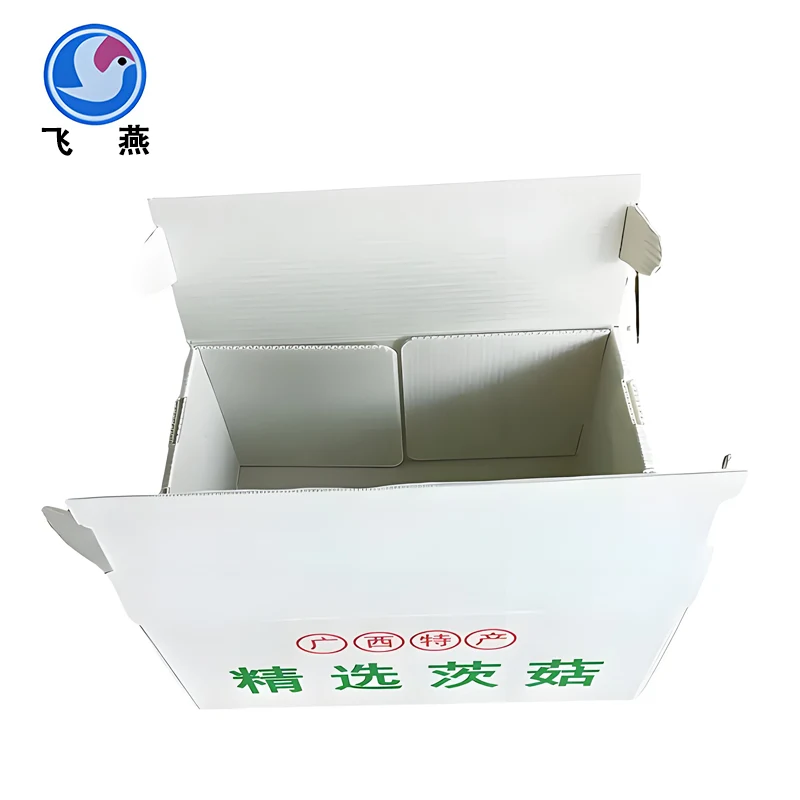When selecting fruit transfer boxes, multiple factors such as fruit characteristics, transportation needs, and storage environments should be comprehensively considered to ensure fruits remain fresh and minimize losses during circulation. The following are detailed selection points and suggestions:
I. Choose Suitable Functions Based on Fruit Characteristics
1. Ventilation Requirements
Fruits Needing Ventilation: Apples, pears, oranges, etc. Require transfer boxes with ventilation holes (aperture about 0.5-1 cm, evenly distributed on the box body) to prevent mildew caused by a closed environment.
Fruits Needing Moisture Retention: Grapes, strawberries, etc. Opt for boxes with sealed lids or inner moisture-proof films to reduce water loss; however, ensure moderate ventilation to avoid suffocation.
Example: For transporting grapes, use boxes with bottom ventilation holes and side ventilation nets, paired with shock-proof paper trays for both breathability and anti-crush protection.
2. Shockproof and Buffer Design
Fragile Fruits: Peaches, cherries, mangoes, etc. Need boxes with internal partition slots, foam linings, or honeycomb paper trays to prevent collisions.
Hard Fruits: Watermelons, honeydews, etc. Choose boxes with strong load-bearing capacity and thick walls to reduce deformation from stacking.
3. Temperature and Moisture Resistance
Cold Chain Transportation: For refrigeration or freezing, use plastic transfer boxes (e.g., HDPE material) resistant to low temperatures (-20°C to 50°C) to avoid cracking.
Humid Environments: In rainy areas or sea transportation, select moisture-resistant materials (e.g., plastic) to prevent wooden boxes from absorbing water and mildewing.
II. Material Selection: Balance Durability and Cost
MaterialAdvantagesDisadvantagesApplicable Scenarios
Plastic (HDPE/PP) Lightweight, wear-resistant, easy to clean, corrosion-resistant, reusable 50-100 times, moderate cost. Brittle at low temperatures, prone to aging under long-term sunlight. Daily transportation, cold storage, e-commerce distribution.
Wood Good air permeability, strong load-bearing capacity, suitable for large fruits (e.g., watermelons) or scenarios requiring natural ventilation. Heavy weight, easy to absorb water and mildew, requires regular disinfection, high cost. Short-distance transportation, high-end fruit packaging.
Metal (Aluminum Alloy) Extremely high strength, impact-resistant, long service life, suitable for mechanized handling (e.g., forklift loading/unloading). Heavy weight, high cost, no air permeability. Factory sorting, long-distance heavy transportation.
Paper/Degradable Materials Environmentally friendly, low cost, suitable for single-use (e.g., e-commerce express). Weak load-bearing, poor moisture resistance. Short-distance distribution of light fruits (e.g., strawberries).
III. Size and Capacity: Adapt to Transportation Tools and Storage Scenarios
1. Priority for Standard Sizes
Common domestic standard sizes: 600×400mm, 500×300mm, 400×300mm, etc. (compatible with pallets and truck containers) to avoid inconvenient stacking or wasted transportation space.
Example: For a truck container with an inner diameter of 2.3×2.3m, choosing 600×400mm boxes allows 4 boxes horizontally and 5 vertically, maximizing space utilization.
2. Capacity and Weight Control
Recommended single-box weight: Small fruits (e.g., cherries) ≤10kg, medium fruits (e.g., apples) ≤20kg, large fruits (e.g., watermelons) ≤30kg for easy manual handling or mechanical loading/unloading.
Depth design: Shallow boxes (height ≤30cm) for easily crushed fruits (e.g., strawberries), deep boxes (height 50-70cm) for hard fruits (e.g., oranges).
IV. Structural Design: Stacking, Handling, and Durability
1. Stacking Performance
The box bottom and lid should have slot or anti-slip patterns to ensure stability when stacked (e.g., the "convex-top and concave-bottom" structure of plastic boxes), preventing collapse during transportation.
Load-bearing test: When empty boxes are stacked, the bottom box should withstand the weight of 5 full boxes (about 100-150kg) without obvious deformation.
2. Handling Convenience
Side handles: Choose embedded or reinforced handles to avoid breakage during handling (plastic box handles should bear ≥30kg).
Mechanical adaptation: For forklifts or conveyors, use boxes with bottom fork holes (fork hole width ≥10cm, depth ≥15cm).
3. Foldability and Storage
Foldable transfer boxes (e.g., plastic foldable boxes) can save over 70% space when empty, suitable for limited warehouse scenarios.
V. Hygiene and Compliance: Essentials for Food Safety
Material Certification: Fruit-contact transfer boxes must comply with Food Contact Plastic Materials and Products (GB 4806.7) standards, avoiding recycled materials (which may contain heavy metals).
Easy Cleaning and Disinfection: Choose boxes with smooth surfaces and no dead corners (e.g., plastic boxes), which can be disinfected with detergent, bleach, or high temperature (heat resistance ≥70℃).
Pest Prevention Design: Box gaps ≤2mm to prevent insect entry; check for residual fruit debris before transportation to avoid mildew attracting pests.
VI. Cost and Cost-effectiveness: Key to Long-term Use
Single-use Cost vs. Reusability:
Plastic transfer boxes: Unit price 20-50 RMB, reusable over 50 times, single-use cost ≤1 RMB, suitable for long-term use.
Paper transfer boxes: Unit price 5-10 RMB, single-use, suitable for short-term or 零散 transportation (scattered transportation).
Maintenance and Replacement Costs: Choose boxes with easily available parts (e.g., plastic box handles can be replaced individually) to reduce overall scrapping losses.
VII. Special Scenario Requirements
E-commerce Express: Select lightweight, shockproof plastic or paper boxes, paired with foam nets and air column bags to prevent 颠簸 during delivery.
Export Transportation: Wooden boxes need IPPC fumigation certification (to prevent cross-border pest spread), and plastic boxes must meet the importing country's environmental standards (e.g., EU REACH regulations).
Cold Storage: Use low-temperature-resistant plastic boxes (-18℃ non-brittle), with temperature ranges marked on the box to avoid deformation in high-temperature environments.
Summary: Selection Process Recommendations
Clarify fruit type (fragile/hard, requiring ventilation/moisture retention) → 2. Determine transportation scenario (short/long distance, cold chain/normal temperature) → 3. Screen materials and sizes → 4. Test load-bearing and stacking performance → 5. Check hygiene certification → 6. Calculate long-term use costs.
By comprehensively considering the above dimensions, fruit loss can be minimized, and turnover efficiency improved. For example, when transporting strawberries, prioritize a PP plastic box with partition slots (size 400×300×15cm), paired with ventilation holes and a moisture-proof lining for both shockproof and moisture retention.
